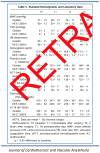Fate of articles that warranted retraction due to ethical concerns: a descriptive cross-sectional study
- PMID: 24465744
- PMCID: PMC3899113
- DOI: 10.1371/journal.pone.0085846
Fate of articles that warranted retraction due to ethical concerns: a descriptive cross-sectional study
Abstract
Objective: To study journals' responses to a request from the State Medical Association of Rheinland-Pfalz, Germany, to retract 88 articles due to ethical concerns, and to check whether the resulting retractions followed published guidelines.
Design: Descriptive cross-sectional study.
Population: 88 articles (18 journals) by the anaesthesiologist Dr. Boldt, that warranted retraction.
Method: According to the recommendations of the Committee on Publication Ethics, we regarded a retraction as adequate when a retraction notice was published, linked to the retracted article, identified the title and authors of the retracted article in its heading, explained the reason and who took responsibility for the retraction, and when the retracted article was freely accessible and marked using a transparent watermark that preserved original content. Two authors extracted data independently (January 2013) and contacted editors-in-chief and publishers for clarification in cases of inadequate retraction.
Results: Five articles (6%) fulfilled all criteria for adequate retraction. Nine (10%) were not retracted (no retraction notice published, full text article not marked). 79 (90%) retraction notices were published, 76 (86%) were freely accessible, but only 15 (17%) were complete. 73 (83%) full text articles were marked as retracted, of which 14 (16%) had an opaque watermark hiding parts of the original content, and 11 (13%) had all original content deleted. 59 (67%) retracted articles were freely accessible. One editor-in-chief stated personal problems as a reason for incomplete retractions, eight blamed their publishers. Two publishers cited legal threats from Dr. Boldt's co-authors which prevented them from retracting articles.
Conclusion: Guidelines for retracting articles are incompletely followed. The role of publishers in the retraction process needs to be clarified and standards are needed on marking retracted articles. It remains unclear who should check that retractions are done properly. Legal safeguards are required to allow retraction of articles against the wishes of authors.
Conflict of interest statement
Figures



Similar articles
-
Why and how do journals retract articles? An analysis of Medline retractions 1988-2008.J Med Ethics. 2011 Sep;37(9):567-70. doi: 10.1136/jme.2010.040964. Epub 2011 Apr 12. J Med Ethics. 2011. PMID: 21486985 Clinical Trial.
-
Why articles are retracted: a retrospective cross-sectional study of retraction notices at BioMed Central.BMJ Open. 2016 Nov 23;6(11):e012047. doi: 10.1136/bmjopen-2016-012047. BMJ Open. 2016. PMID: 27881524 Free PMC article.
-
Retracted Publications Within Radiology Journals.AJR Am J Roentgenol. 2016 Feb;206(2):231-5. doi: 10.2214/AJR.15.15163. AJR Am J Roentgenol. 2016. PMID: 26797347
-
Research misconduct in health and life sciences research: A systematic review of retracted literature from Brazilian institutions.PLoS One. 2019 Apr 15;14(4):e0214272. doi: 10.1371/journal.pone.0214272. eCollection 2019. PLoS One. 2019. PMID: 30986211 Free PMC article.
-
An examination of retracted articles in nursing literature.J Nurs Scholarsh. 2024 May;56(3):478-485. doi: 10.1111/jnu.12952. Epub 2023 Dec 20. J Nurs Scholarsh. 2024. PMID: 38124265 Review.
Cited by
-
Post retraction citations among manuscripts reporting a radiology-imaging diagnostic method.PLoS One. 2019 Jun 13;14(6):e0217918. doi: 10.1371/journal.pone.0217918. eCollection 2019. PLoS One. 2019. PMID: 31194762 Free PMC article.
-
Media and social media attention to retracted articles according to Altmetric.PLoS One. 2021 May 12;16(5):e0248625. doi: 10.1371/journal.pone.0248625. eCollection 2021. PLoS One. 2021. PMID: 33979339 Free PMC article.
-
Perpetuation of Retracted Publications Using the Example of the Scott S. Reuben Case: Incidences, Reasons and Possible Improvements.Sci Eng Ethics. 2016 Aug;22(4):1063-1072. doi: 10.1007/s11948-015-9680-y. Epub 2015 Jul 7. Sci Eng Ethics. 2016. PMID: 26150092
-
Retraction of papers authored by Yuhji Saitoh - Beyond the Fujii phenomenon.Indian J Anaesth. 2019 Jul;63(7):571-584. doi: 10.4103/ija.IJA_267_19. Indian J Anaesth. 2019. PMID: 31391621 Free PMC article.
-
Beautiful small: Misleading large randomized controlled trials? The example of colloids for volume resuscitation.J Anaesthesiol Clin Pharmacol. 2015 Jul-Sep;31(3):394-400. doi: 10.4103/0970-9185.161680. J Anaesthesiol Clin Pharmacol. 2015. PMID: 26330723 Free PMC article.
References
-
- EIC Joint Statement on Retractions Available:http://journals.lww.com/ejanaesthesiology/Documents/EIC%20Joint%20Statem.... Accessed 12 August 2013.
-
- Wager E, Barbour V, Yentis S, Kleinert S on behalf of COPE Council. Retractions: Guidance from the Committee on Publication Ethics (COPE) Available:http://publicationethics.org/files/u661/Retractions_COPE_gline_final_3_S.... Accessed 12 August 2013.
-
- Errata, Retractions, Partial Retractions, Corrected and Republished Articles, Duplicate Publications, Comments (including Author Replies), Updates, Patient Summaries, and Republished (Reprinted) Articles Policy for MEDLINE®. Available:http://www.nlm.nih.gov/pubs/factsheets/errata.html. Accessed 12 August 2013.
-
- Research institutions guidelines. Available:http://publicationethics.org/files/Research_institutions_guidelines_fina.... Accessed 12 August 2013.
-
- Sox HC, Rennie D (2006) Research misconduct, retraction, and cleansing the medical literature: Lessons from the Poehlman case. Ann Intern Med 144: 609–13. - PubMed
MeSH terms
LinkOut - more resources
Full Text Sources
Other Literature Sources

